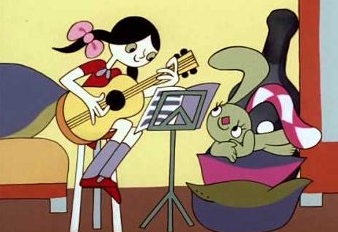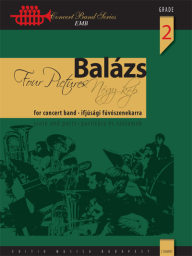Band Music News
Balázs Árpád: Variations on a Theme by Elgar
|
In Árpád Balázs's diverse and varied oeuvre, works for wind orchestra play a prominent role alongside choral music. He composed the Elgar Variations in 2022 on the theme of one of Edward Elgar's (1857-1934) short early works (Love's Greetings, 1888). As Árpád Balázs writes ''The theme I used as the starting point for my work may already be considered a variation, since I 'peeled off' the dense ornamentation and the tonicisations from it, and what remained was the melody, beautiful in its own place. What come back from time to time from the theme in the variations are: the arched structure, the double peak point, and mostly the major sixth leaping downwards, then upwards. The modest, transparent orchestration, which then is amplified at the repetition of the theme is also a defining feature. There is a personal family secret hidden in the third variation: a late compliment to a loyal spouse for the past half century... The closing variation is calm and quiet - similarly to the chorale-like slow movement in Béla Bartók's 3rd Piano Concerto. It is like a message from an old composer to the Future.'' |
Buzzing Polka
|
Buzzing Polka, composed in 1993, is one of the earliest compositions by László Dubrovay (*1943) for concert band, which has become a huge success due to use of special timbres and effects which had been unexploited in the genre earlier. Already the title tells that classical musical values and surprising moments of special brass instrument techniques can be both found in the work. Every second in the striking character piece is made interesting by the excellent balance between the pillar-like harmonies enriched by distant overtones and horizontal melody formation. Performing Buzzing Polka is a great opportunity for conveying the message and values of the music of the 20th and 21st centuries through the contrast between classical melodies and new ways of instrumentation. |
After Mozart
|
László Dubrovay's work, written in 2006, on the 250th anniversary of Mozart's birth, is a salute of a 21st-century composer to one of the greatest geniuses in the history of music. The composer builds his original ideas on one of the best-known melodies of The Marriage of Figaro (Figaro's aria: ''Non pi? andrai, farfallone amoroso''). The series of variations on the theme of the aria is created by the involvement of special instruments, and by fully harnessing their technical abilities, while Dubrovay's hallmark of a perfect balance and peculiar compositional tone is realised on an exceptionally large orchestra. The work is suited to illustrate the potentials of crossovers between different periods in the history of music, but it can also be played at a festive, thematic concert. |
Two new titles by Árpád Balázs have been published
|
Kuruc Scenes The composer uses melodies from the early 18th century, from the age of Rákóczi's war of independence. Rhapsody Rhapsody follows the one-movement structure created by Franz Liszt. The Rhapsody is a passionately emotional lyric orchestral poem rich in colours and characters, which has a place on the repertoire of every concert band playing quality music. Publisherd by Universal Music Publishing Editio Musica Budapest |
Two new titles for concert band

Two new titles by Árpád BALÁZS have been published in the Concert Band series.
Árpád BALÁZS: Kuruc Scenes
for tárogató or soprano saxophone
and concert band
The composer uses melodies from the early 18th century, from the age of Rákóczi's war of independence.
Árpád BALÁZS: Rhapsody
for cimbalom or marimba
and concert band
Rhapsody follows the one-movement structure created by Franz Liszt. The Rhapsody is a passionately emotional lyric orchestral poem rich in colours and characters, which has a place on the repertoire of every concert band playing quality music.
Publisher: Universal Music Publishing Editio Musica Budapest
One full score as well as individual parts are provided for each work.
Music with Chequered Ears
 Television viewers of nearly a hundred countries have experienced Árpád Balázs's touching melodies. The series of cartoons have neither dialogue nor text: the music presents the amiable and entertaining adventures of the rabbit with chequered ears and its friends. Balázs has rephrased and developed the well-known melodies and as a result a ''children's story symphony'' of seven movements has been created in which, in contrast with Prokofiev's Peter and the Wolf, there is no narrator but the instruments themselves represent the story-tellers. The composer has again associated the groups of instruments with one another in a colourful and varied manner, skilfully alternating the modes of solo, chamber orchestra and orchestra. Movements I, II, IV and VII represent a ''short suite'' that can be independently performed, thus due to its duration of four minutes and easier level, ensembles with more modest opportunities can also perform it. The most well-known parts of the cartoon series music - the main title and the ending - are included in both versions.
Television viewers of nearly a hundred countries have experienced Árpád Balázs's touching melodies. The series of cartoons have neither dialogue nor text: the music presents the amiable and entertaining adventures of the rabbit with chequered ears and its friends. Balázs has rephrased and developed the well-known melodies and as a result a ''children's story symphony'' of seven movements has been created in which, in contrast with Prokofiev's Peter and the Wolf, there is no narrator but the instruments themselves represent the story-tellers. The composer has again associated the groups of instruments with one another in a colourful and varied manner, skilfully alternating the modes of solo, chamber orchestra and orchestra. Movements I, II, IV and VII represent a ''short suite'' that can be independently performed, thus due to its duration of four minutes and easier level, ensembles with more modest opportunities can also perform it. The most well-known parts of the cartoon series music - the main title and the ending - are included in both versions.Hungarian Rondo
The Hungarian Rondo by Árpád Balázs is cheerful, good-humoured music, a finely formed work crafted withgreat professional skill.
Its structure is clear: the double recurrence of the rondo theme results in a five-part form. The two episodes differ in character. The first consists of increasingly densely woven imitations that chase eachother playfully; the second evokes the mood of bagpipe tunes. In the latter, above the melody moving evenly incrotchets in the middle parts a pastel-tinted cloud of woodwind notes floats upwards, while the sound is extended downwards by the deep-toned brass stepping lower by semitones. A brilliant device by the composer! In thecourse of its repeats the rondo theme appears more and more richly garbed; particularly the sparkling semiquavers of the woodwind make it ever more decorative.
The Hungarian Rondo is the kind of music that drives your cares away.
 Deutsch
Deutsch English
English Español
Español Français
Français Magyar
Magyar Polski
Polski Slovenský
Slovenský Slovenščina
Slovenščina 中文
中文


























